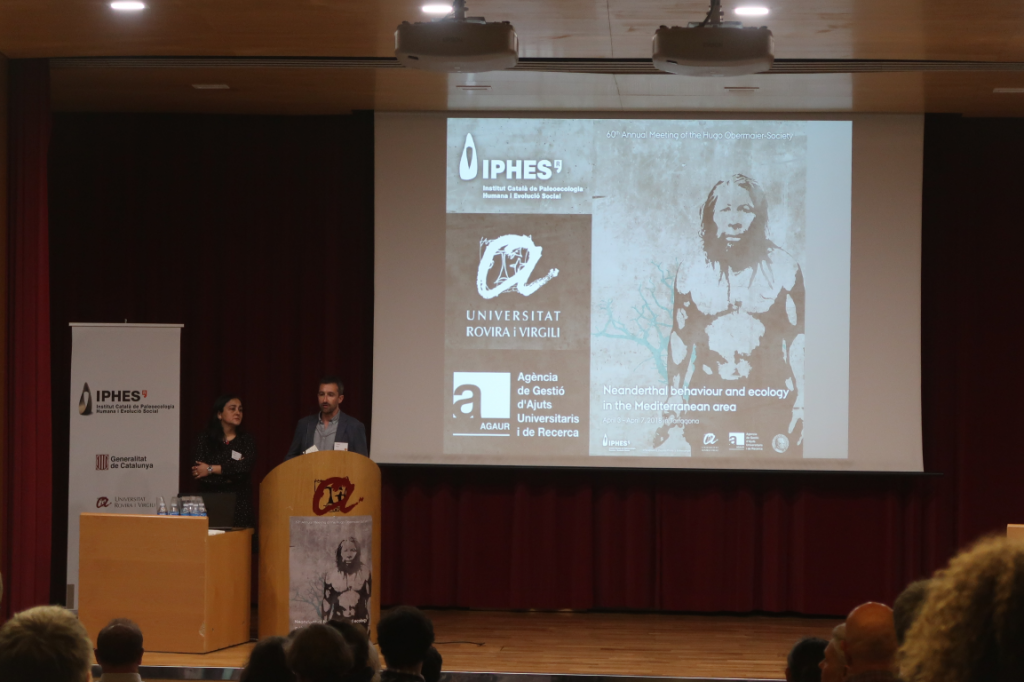04/04/2018
European experts present the latest research on the behaviour of Neanderthals and their environment
The event took place at the 60th International Conference of the Hugo Obermaier Society in Tarragona from 3 to 7 April

The event took place at the 60th International Conference of the Hugo Obermaier Society in Tarragona from 3 to 7 April
The central topic of the 60th International Congress of the Hugo Obermaier Society was the behaviour and environment of Neanderthal communities in the Mediterranean. The event took place in the Main Lecture Theatre at the Catalunya Campus of the Universitat Rovira i Virgili in Tarragona from 3 to 7 April. The event brought together over a hundred experts from different European institutions to present the latest research on this topic.
As part of the conference, attendees visited the sites of the Coves del Toll (Moià) and the Abric Romaní (Capellades), both in the province of Barcelona, where the Catalan Institute of Human Paleoecology and Social Evolution (abbreviated in Catalan as IPHES) is carrying out research that have turned both places into international points of reference in the study of everyday life and the social evolution of Neanderthals. On 7 April the scientific route took participants to the Abric dels Rossegadors (La Pobla de Benifassà), the Abrics de l’Ermita (Ulldecona) and the Museu de les Terres de l’Ebre (Amposta).
Researchers in prehistory from institutions in Germany, Spain, Italy, Hungary, the Czech Republic and England came to the congress, bringing together a total of 110 specialists who presented 32 papers and 17 posters on the latest developments in the study of Neanderthals.
Every two years the Hugo Obermaier Society holds its annual conference outside Germany where it is based. Two years ago the IPHES presented its candidacy and in 2017 the Hugo Obermaier Society confirmed that the 60th congress would be held in Tarragona where the IPHES is located. Each year the host institution is able to choose the conference theme, and so this year the IPHES proposed one of its main research lines, the study of Neanderthal populations, with the second day of the conference being entirely dedicated to this subject. The IPHES contributed 3 papers and 4 posters on its different Neanderthal projects, focusing on the sites of Abric Romaní and Teixoneres in Barcelona and Maltravieso in Cáceres.
In addition, IPHES members are involved in 3 research projects with other international teams on the sites of Schöningen (Germany), Nadale Cave (Italy) and Kabazi II, Siuren I, Chokurcha (Crimea).
Local heritage of global interest
The scientific visits to the Coves del Toll in Moià and the Abric Romaní in Capellades meant that the international experts had the opportunity to discuss the main findings at these sites first hand.
The mayor of Moià, Dionís Guiteras, expressed his satisfaction with this initiative: “It is a great opportunity to increase the international visibility of our sites and to position them in their rightful place in the world of science,” he said. “At the town hall we have always been committed to raising awareness of our heritage, so it is a great honour for us to be visited by so many specialists.”
Similarly, Aleix Auber, the mayor of Capellades, stated that “due to both its archaeological record and the scientific research carried out, the Abric Romaní has become one of the country’s leading Palaeolithic sites. This town council fully supports the continuation of the research work carried out by the IPHES. Receiving prehistoric specialists from all over Europe is an excellent opportunity to show in situ all the research work being carried out at the most important site of our local archaeological heritage.”
The participants visited the Coves del Toll on the morning of 6 April, and in the afternoon they went to Capellades to visit the Abric Romaní.
